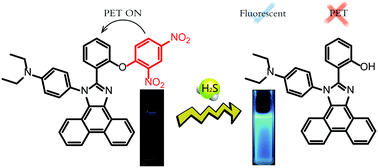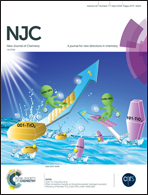A novel fluorescent probe for selective detection of hydrogen sulfide in living cells†
Abstract
A novel fluorescent probe for the detection of H2S in living cells was designed and synthesized by introducing 2,4-dinitrophenyl ether into a phenanthroimidazole derivative. The structures of the fluorophore and the probe were characterized using 1H NMR, 13C NMR and mass spectra. The probe shows excellent sensitivity, and the detection limit is 1.11 μM. High selectivity and competition are also revealed in corresponding studies. The probe can be applied in a wide pH range. Cellular assays indicate that the cytotoxicity of the probe is low, and the cellular permeability is good. With these desirable properties, the probe demonstrates a possible approach for investigating the biological roles of H2S in living tissues.



 Please wait while we load your content...
Please wait while we load your content...